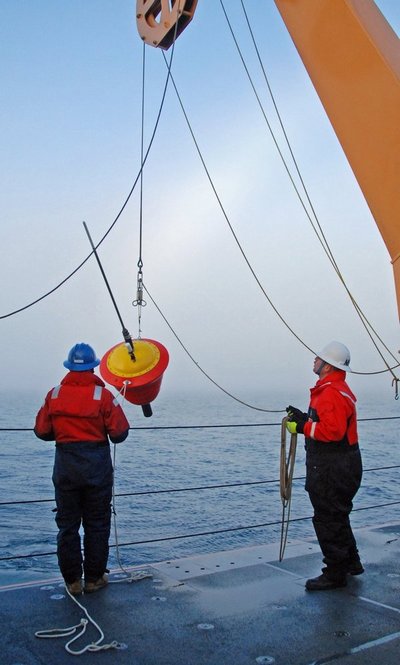October 12, 2010
Fact Sheet: New buoy designed to gather information in changing Arctic
Update Oct. 14, 2010: The buoy deployed Oct. 12 in the Arctic Ocean from a U.S. Coast Guard C-130 has yet to transmit a signal. During the airdrop of the Airborne eXpendable Ice Beacon, or AXIB for short, the parachute carrying the buoy to the water appeared to have cut loose just a few seconds too soon and the buoy hit the water harder than it should have, according to Ignatius Rigor, senior research scientist with the University of Washington’s Applied Physics Laboratory.
The cutter for the parachute is on a timer and ideally the chute disconnects from the buoy just before it lands in the water. That way the chute doesn’t become tangled with the buoy, possibly breaking off antennas or sinking the buoy, Rigor says.
Airdrops can be the easiest, least costly way to deploy instruments into the Arctic Ocean and the loss of this particular buoy is an example of the challenges of deploying instruments in the far north, Rigor says. The next airdrop of an AXIB is planned for Oct. 26.
- A new buoy designed to collect information both in ice floes and open ocean is being air dropped today (Oct. 12, 2010) into the Arctic Ocean by a U.S. Coast Guard C-130. The Airborne eXpandable Ice Beacon, or AXIB, passed stringent air-drop certification by the Coast Guard earlier this year and this is its first air drop as a fully operational research tool.
- “The buoys can provide crucial data for weather and ice forecasting used for tracking the direction and intensity of storms, some of which affect Alaska,” says Roger Anderson, a senior mathematician with the UW’s Applied Physics Laboratory who is overseeing the airdrop. “The data also will be used by scientists in climate models and to try to understand the changes occurring in the Arctic and around the globe.”
- The state of the Arctic is of concern because Arctic sea ice has retreated extensively in the summer for the past decade, with the last four summers setting records for how little ice cover remained at the end of the melt season, according to Ignatius Rigor, senior research scientist at the UW’s Applied Physics Laboratory. With these retreats, warmer ocean and air temperatures have been recorded, especially north of Alaska.
- The Arctic Ocean now has less ice for parts of the year so a buoy was needed that can collect data while floating in open water as much as — or perhaps more than — when embedded in ice. The current mainstay in arctic monitoring, for instance, is the ICEX buoy, in use since the 1980s, but designed to be air dropped onto thick ice and spend its life there.
- The new Airborne eXpendable Ice Beacon buoys were developed as a partnership between the Polar Science Center at the UW’s Applied Physics Laboratory, U.S. Coast Guard and National Ice Center. Prototypes deployed in the last two years led to the manufacture of this new buoy. It measures such things as air pressure and temperature, winds, upper ocean temperature, ice and snow temperatures and movement of the ice. Each buoy costs about $18,000.
- The buoys will be part of the International Arctic Buoy Program currently collecting and sharing data from more than 100 buoys deployed by 30 institutions from 10 individual countries and the European Union. The program, which originated at the UW’s Applied Physics Laboratory in 1979, is currently coordinated by Rigor.
###
For more information after the flight concludes:
Rigor, 206-685-2571, ignatius@apl.washington.edu
More about International Buoy Program: http://iabp.apl.washington.edu/
UW Polar Science Center, Applied Physics Laboratory: http://psc.apl.washington.edu/
National Ice Center: http://www.natice.noaa.gov/mission.html?bandwidth=high

